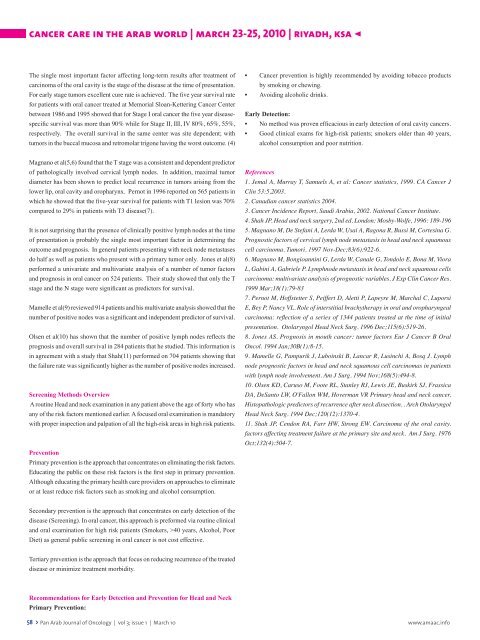Pan Arab Journal of Oncology - Arab Medical Association Against ...
Pan Arab Journal of Oncology - Arab Medical Association Against ...
Pan Arab Journal of Oncology - Arab Medical Association Against ...
Create successful ePaper yourself
Turn your PDF publications into a flip-book with our unique Google optimized e-Paper software.
cancer care in the arab world | march 23-25, 2010 | riyadh, ksa <<br />
The single most important factor affecting long-term results after treatment <strong>of</strong><br />
carcinoma <strong>of</strong> the oral cavity is the stage <strong>of</strong> the disease at the time <strong>of</strong> presentation.<br />
For early stage tumors excellent cure rate is achieved. The five year survival rate<br />
for patients with oral cancer treated at Memorial Sloan-Kettering Cancer Center<br />
between 1986 and 1995 showed that for Stage I oral cancer the five year diseasespecific<br />
survival was more than 90% while for Stage II, III, IV 80%, 65%, 55%,<br />
respectively. The overall survival in the same center was site dependent; with<br />
tumors in the buccal mucosa and retromolar trigone having the worst outcome. (4)<br />
Magnano et al(5,6) found that the T stage was a consistent and dependent predictor<br />
<strong>of</strong> pathologically involved cervical lymph nodes. In addition, maximal tumor<br />
diameter has been shown to predict local recurrence in tumors arising from the<br />
lower lip, oral cavity and oropharynx. Pernot in 1996 reported on 565 patients in<br />
which he showed that the five-year survival for patients with T1 lesion was 70%<br />
compared to 29% in patients with T3 disease(7).<br />
It is not surprising that the presence <strong>of</strong> clinically positive lymph nodes at the time<br />
<strong>of</strong> presentation is probably the single most important factor in determining the<br />
outcome and prognosis. In general patients presenting with neck node metastases<br />
do half as well as patients who present with a primary tumor only. Jones et al(8)<br />
performed a univariate and multivariate analysis <strong>of</strong> a number <strong>of</strong> tumor factors<br />
and prognosis in oral cancer on 524 patients. Their study showed that only the T<br />
stage and the N stage were significant as predictors for survival.<br />
Mamelle et al(9) reviewed 914 patients and his multivariate analysis showed that the<br />
number <strong>of</strong> positive nodes was a significant and independent predictor <strong>of</strong> survival.<br />
Olsen et al(10) has shown that the number <strong>of</strong> positive lymph nodes reflects the<br />
prognosis and overall survival in 284 patients that he studied. This information is<br />
in agreement with a study that Shah(11) performed on 704 patients showing that<br />
the failure rate was significantly higher as the number <strong>of</strong> positive nodes increased.<br />
Screening Methods Overview<br />
A routine Head and neck examination in any patient above the age <strong>of</strong> forty who has<br />
any <strong>of</strong> the risk factors mentioned earlier. A focused oral examination is mandatory<br />
with proper inspection and palpation <strong>of</strong> all the high-risk areas in high risk patients.<br />
Prevention<br />
Primary prevention is the approach that concentrates on eliminating the risk factors.<br />
Educating the public on these risk factors is the first step in primary prevention.<br />
Although educating the primary health care providers on approaches to eliminate<br />
or at least reduce risk factors such as smoking and alcohol consumption.<br />
Secondary prevention is the approach that concentrates on early detection <strong>of</strong> the<br />
disease (Screening). In oral cancer, this approach is preformed via routine clinical<br />
and oral examination for high risk patients (Smokers, >40 years, Alcohol, Poor<br />
Diet) as general public screening in oral cancer is not cost effective.<br />
Tertiary prevention is the approach that focus on reducing recurrence <strong>of</strong> the treated<br />
disease or minimize treatment morbidity.<br />
Recommendations for Early Detection and Prevention for Head and Neck<br />
Primary Prevention:<br />
• Cancer prevention is highly recommended by avoiding tobacco products<br />
by smoking or chewing.<br />
• Avoiding alcoholic drinks.<br />
Early Detection:<br />
• No method was proven efficacious in early detection <strong>of</strong> oral cavity cancers.<br />
• Good clinical exams for high-risk patients; smokers older than 40 years,<br />
alcohol consumption and poor nutrition.<br />
References<br />
1. Jemal A, Murray T, Samuels A, et al: Cancer statistics, 1999. CA Cancer J<br />
Clin 53:5,2003.<br />
2. Canadian cancer statistics 2004.<br />
3. Cancer Incidence Report, Saudi <strong>Arab</strong>ia, 2002. National Cancer Institute.<br />
4. Shah JP. Head and neck surgery, 2nd ed. London: Mosby-Wolfe, 1996: 189-196<br />
5. Magnano M, De Stefani A, Lerda W, Usai A, Ragona R, Bussi M, Cortesina G.<br />
Prognostic factors <strong>of</strong> cervical lymph node metastasis in head and neck squamous<br />
cell carcinoma. Tumori. 1997 Nov-Dec;83(6):922-6.<br />
6. Magnano M, Bongioannini G, Lerda W, Canale G, Tondolo E, Bona M, Viora<br />
L, Gabini A, Gabriele P. Lymphnode metastasis in head and neck squamous cells<br />
carcinoma: multivariate analysis <strong>of</strong> prognostic variables. J Exp Clin Cancer Res.<br />
1999 Mar;18(1):79-83<br />
7. Pernot M, H<strong>of</strong>fstetter S, Peiffert D, Aletti P, Lapeyre M, Marchal C, Luporsi<br />
E, Bey P, Nancy VL. Role <strong>of</strong> interstitial brachytherapy in oral and oropharyngeal<br />
carcinoma: reflection <strong>of</strong> a series <strong>of</strong> 1344 patients treated at the time <strong>of</strong> initial<br />
presentation. Otolaryngol Head Neck Surg. 1996 Dec;115(6):519-26.<br />
8. Jones AS. Prognosis in mouth cancer: tumor factors Eur J Cancer B Oral<br />
Oncol. 1994 Jan;30B(1):8-15.<br />
9. Mamelle G, Pampurik J, Luboinski B, Lancar R, Lusinchi A, Bosq J. Lymph<br />
node prognostic factors in head and neck squamous cell carcinomas in patients<br />
with lymph node involvement. Am J Surg. 1994 Nov;168(5):494-8.<br />
10. Olsen KD, Caruso M, Foote RL, Stanley RJ, Lewis JE, Buskirk SJ, Frassica<br />
DA, DeSanto LW, O'Fallon WM, Hoverman VR Primary head and neck cancer.<br />
Histopathologic predictors <strong>of</strong> recurrence after neck dissection. . Arch Otolaryngol<br />
Head Neck Surg. 1994 Dec;120(12):1370-4.<br />
11. Shah JP, Cendon RA, Farr HW, Strong EW. Carcinoma <strong>of</strong> the oral cavity.<br />
factors affecting treatment failure at the primary site and neck. Am J Surg. 1976<br />
Oct;132(4):504-7.<br />
58 > <strong>Pan</strong> <strong>Arab</strong> <strong>Journal</strong> <strong>of</strong> <strong>Oncology</strong> | vol 3; issue 1 | March 10 www.amaac.info









